You’re walking across a moor, high in Northumberland’s Cheviot Hills, on a summer day. Bees hum in the heather; clouds move drowsily across the sky; a pleasant breeze ripples over your skin. And then you see it. You blink, look again, but it’s definitely there.
The day seems to darken. You wonder if – instead of stepping on springy turf – you’ve stepped through some portal out of the 21st century and back into a more gruesome epoch. Because there – on a hillock next to a quiet B-road – you can make out a gibbet.
There’s that gallows shape – that grim, almost archetypal structure – like a signpost pointing the way out of this existence and into the afterlife. A shape long feared by our forefathers and foremothers, a bleak reminder of the powers of the Establishment and State, a power that even intruded into the remotest regions.
Hanging from that gibbet is some kind of rope, chain or bar and attached to that is the unmistakable outline of a human head. As you come closer, you hear a groaning, a creaking, as that head sways in the wind – a sound that’s somehow burned onto the ancestral memory, a noise evoking images of the bodies of malefactors suspended in cages or chains.
Though such a sight is unusual, it’s not the only one. Scattered around England are reminders of our nation’s grisly past: the gibbets, the gallows, the memorials that mark the places where – across the centuries – the State delivered the ultimate penalty to its more wayward subjects.
A gibbet can simply mean the apparatus of execution – a term that includes gallows (where people were killed by hanging), guillotines, the executioner’s block or even the scaffold upon which such implements stood. To gibbet means to extend the punishment beyond death – to wrap the corpse of the wrongdoer in chains or put it in a cage and then display the body publicly by suspending it from a tall gallows-like structure (also known as a gibbet).
The rotting corpse would dangle – sometimes for years – as a warning to any tempted to stray down the same path. There it would hang, a banquet for maggots and crows, wafting its stomach-turning scent as the chain creaked in the breeze and the cage knocked against the gibbet’s wood. Gibbeting was seen as a horrendous extra punishment in an era when ideas were widespread about the destiny of the soul being intertwined with the body’s fate.
Below I’ve listed ten places in England where you can still see some indications of these brutal histories – perhaps a replica gallows or gibbet, a noose, the rusting remnants of a cage, or an eerily decaying post. Read on to learn about cursed chairs, skulls in town hall attics, murderers’ ghosts, the grim punishments that awaited pirates and mutineers, England’s only guillotine, and the strangest ever cures for toothache and rheumatism.
Number 1: Steng Cross Gibbet, Northumberland
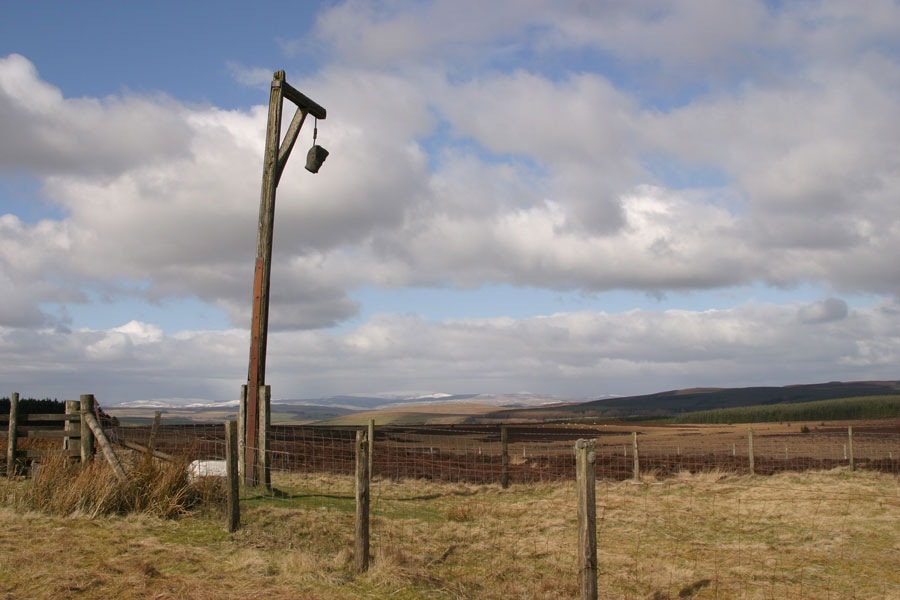
Steng Cross Gibbet, Northumberland, England (Photo: Phil Thirkell)
The description above is of Steng Cross Gibbet – also known as Winter’s Gibbet – in Northumberland. Northumberland – being close to Scotland and a hangout of cattle rustlers and cross-border raiders – was a popular place for gibbets, but this particular relic has nothing to do with Scottish interlopers or livestock thieves.
Steng Cross Gibbet – located on bleak moorland next to the B6342 about eight miles (12.87 kilometres) east of Otterburn – is an 18-foot (5.48-metre) replica of the gibbet that once suspended the corpse of William Winter.
Winter – a wanderer and highwayman – had crept up to an isolated cottage near Whiskershield Common one rainswept blustery night in 1791. Urged on by two sisters – Jane and Eleanor Clark – Winter knocked on the door and begged the cottage’s sole occupant, an elderly woman, for shelter. The lady beckoned him in and Winter repaid her kindness by beating and kicking her, slitting her throat and escaping with her possessions loaded on a donkey.
Winter and his two accomplices felt that – in such a lonely spot – it would take a while for the victim to be discovered, giving them plenty of time to get away. But the gang were seen by a shepherd boy, who recognised a knife Winter was using to peel an apple as belonging to the old woman. The boy also took note of the patterns on the soles of Winter’s boots, enabling the authorities to track the robbers via his footprints in the mud.
The three were arrested, tried in Newcastle and condemned to death by hanging. The judge ordered that Winter’s body should be suspended in chains. (The bodies of the sisters were given up for dissection – gibbeting was a punishment almost exclusively reserved for men.)
The site chosen for Winter’s Gibbet was significant. Due to the stench and risk of contamination, it was preferable to locate gibbets away from populated areas, but – to have a deterrent effect – they needed to be where people would see them.
Roadsides were often, therefore, used, as it was hoped the gibbets would have an invigorating influence on the morals of those passing by. Winter’s Gibbet is located on the highest point of an important road along which Scottish drovers herded their cattle to English markets. This point was once marked by a stone Saxon cross – the base of which only now remains – hence the name Steng Cross Gibbet.
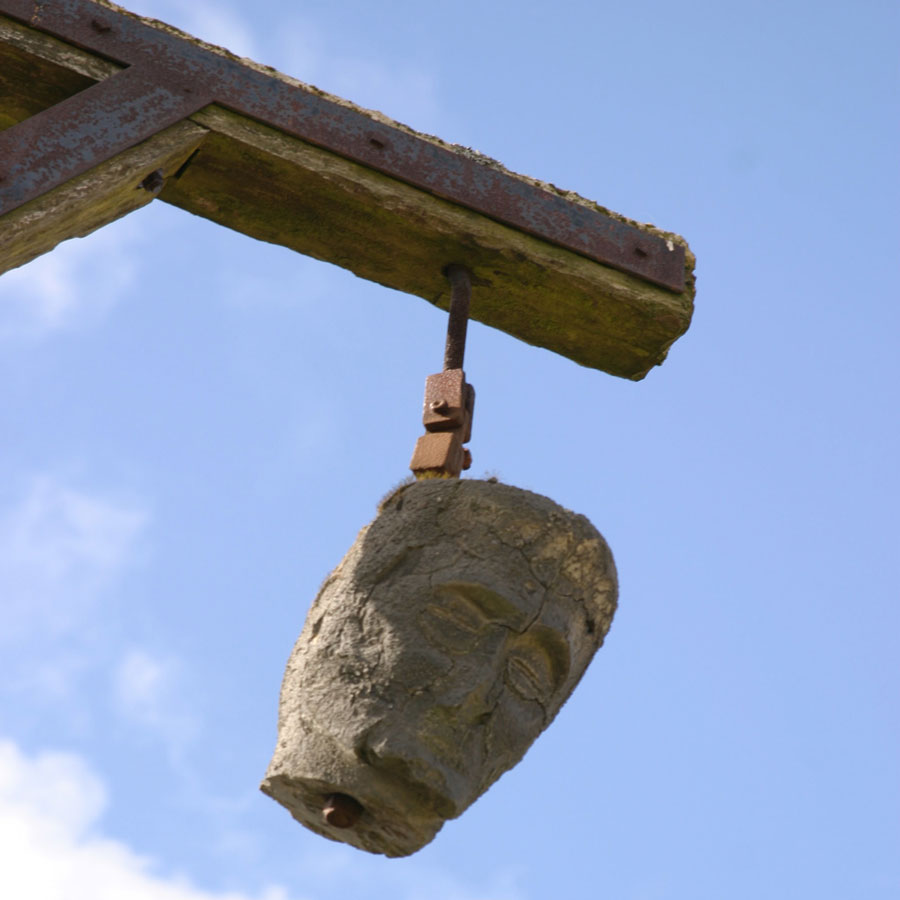
The head suspended from Winter’s Gibbet, Northumberland, England (Photo: Phil Thirkell)
Winter’s body hung on the gibbet until it rotted away. After that, his bones were scattered, though his skull was sent to a Mr Darnell in Newcastle. Winter’s ghost is rumoured to haunt the surrounding moorlands. His phantom is fond of causing sudden thick fogs and of appearing at a nearby cattle grid.
An interesting superstition is linked to Winter’s Gibbet. It’s said you can cure toothache by cutting a splinter off and rubbing it on the offending tooth or gum. Objects associated with executions were long believed to have magical or healing properties. Pieces of a hanged man’s clothing or skin were prized as talismans. Burglars believed the preserved hand of an executed felon – known as a Hand of Glory – could trap their victims in a profound sleep. The fact the current Winter’s Gibbet is just a replica doesn’t seem to have weakened its reputation for curing dental distress.
The head suspended from Steng Cross Gibbet is a concrete one. Once there was a whole concrete body, but as people kept using it for shooting practice or stealing it to play pranks, the body was removed, with only the head remaining.
Number 2: The Busby Stoop Inn, North Yorkshire
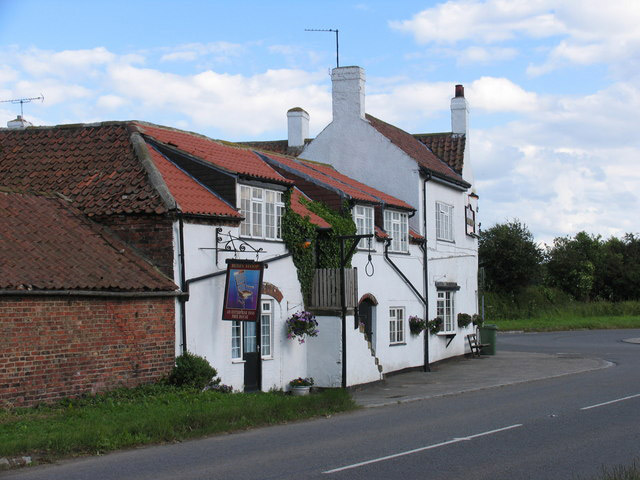
A noose hangs from a mock gallows outside the Busby Stoop Inn, Yorkshire, England (Photo: David Rogers)
If you were driving towards Sand Hutton Crossroads, near Thirsk, North Yorkshire, you might be surprised to see a noose dangling from a gallows beside a white building.
That building is the Busby Stoop Inn and the noose and gallows recall a sinister legend connected with the pub.
The landlord, Thomas Busby, was a notorious drunkard and criminal. One day in 1702, he quarrelled with his father-in-law. Some say it was because the older man was trying to rescue his daughter from Busby, others that the argument concerned a coin counterfeiting gang they were involved with. Anyway, Busby lost his temper and bludgeoned his father-in-law to death.
Busby was sentenced to be hung on the other side of the crossroads from his inn, after which his body was gibbetted and left for years to sway and creak in the wind on the same spot. Before his execution, however, Busby was permitted to have one last drink in his pub. He sat in his favourite chair and – when he got up to face the rope – he is said to have cursed the seat, warning that anyone who sat in it would meet a premature and violent death.
Over the years, a number of people have been unwise enough to sit in Busby’s chair, and all have – apparently – succumbed to his curse. A young labourer – tricked by his colleagues into sitting on the seat – the same day fell through the roof of the house he was working on and split open his skull. Some Canadian airmen, stationed near the Busby Stoop Inn during the Second World War, dared each other to sit on the chair. Shortly afterwards, their plane crashed, killing everyone on board.
One of the pub’s landlords, disturbed by such stories, hid the chair in the cellar. But one day a man delivering beer spotted the seat and decided to take a rest. A few hours later, his lorry crashed, killing him. The chair is now kept in a museum in the nearby town of Thirsk, hung high on a wall so no one is tempted to test whether the curse is true. There’s some dispute about this chair, however, with some claiming its style – with machine-turned spindles – would date it to after Busby’s lifetime.
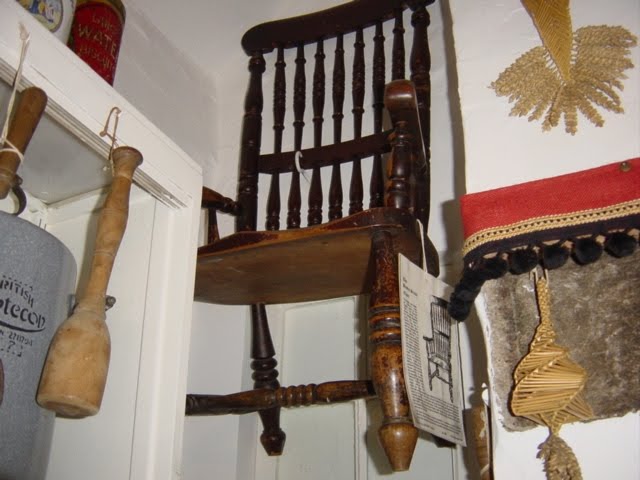
The infamous cursed chair of Thomas Busby (Photo: TheHauntedPalace)
Thomas Busby’s ghost has long been said to haunt the inn as well as the site where he was hung and gibbeted. Crossroads were a popular location for gibbets and gallows. As they were often busy junctions, it was hoped the sight of the gibbeted corpse would be a powerful moral reminder to travellers going by. Crossroads could also be places of burial: the remains of criminals might be interred beneath the gallows they’d been hung from while suicides – a stake driven through their hearts – were sometimes buried at such junctions. Many believed this meant the vengeful or disturbed ghosts of these tragic individuals – confused by the choice of four ways – wouldn’t wander off to haunt nearby settlements.
The pub later renamed itself the Busby Stoop Inn, stoop meaning gallows in the local dialect. Perhaps this – in addition to the mock scaffold and noose outside – was an attempt to cash in on Busby’s legend. Busby’s chair also featured on the pub sign – until recently, that is.
The Busby Stoop Inn is an inn no longer. It’s been converted into an Indian restaurant called Jaipur Spice. There’s no evidence, however, that this change of function has caused Thomas Busby’s ghost to disappear. Perhaps he’s developed a taste for biryani and balti.
Number 3: Execution Dock, Wapping, East London
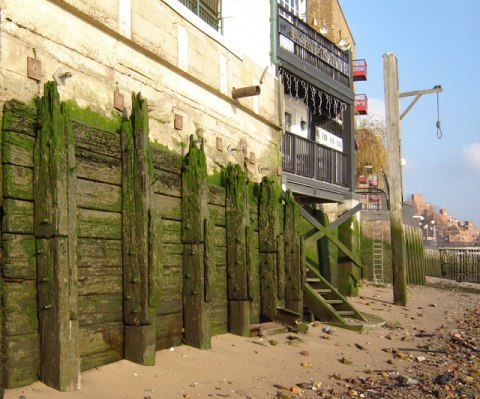
A gallows near the site of Execution Dock, Wapping, London, England (Photo: Historic UK)
When the tide is low, descend the Pelican Stairs by The Prospect of Whitby pub, making sure you don’t slip on the mud or moss coating the steps. If you then pick your way along the Thames foreshore and lift your eyes from examining the pottery shards, the old clay pipes, the urban debris strewn over the river’s exposed bed, you’ll see a gibbet rising from the sand, with a noose dangling from a surprisingly short rope.
You’re near the site of Execution Dock, Wapping, where for over four centuries pirates, mutineers and smugglers were hanged. Those executed here had been sentenced by the Admiralty courts, whose jurisdiction covered all crimes committed at sea.
The gallows at Execution Dock were just below the low tide mark of the river – the gibbet, therefore, fell within the Admiralty’s domains. Crimes for which sailors were hung included murder on the high seas, acts of mutiny that led to death, and other offences, such as sodomy. The Admiralty sought to bring all those found guilty back to London, to end their earthly span at Execution Dock.
The convicts were normally kept in Marshalsea Prison, on the south bank of the Thames, though some were held at Newgate, where the Old Bailey now stands. Prisoners destined for Execution Dock found themselves taking part in quite a spectacle. They were placed on a cart and transported in a parade that went across London Bridge and past the Tower of London. The procession was led by the High Court Marshall on horseback, who brandished a silver oar representing the power of the Admiralty.
A chaplain travelled in the cart with the condemned, urging them to make one last confession. Perhaps more curiously, the procession stopped at an inn – The Turk’s Head – where the prisoner was allowed one final quart of ale. Enthusiastic crowds lined the parade route and river banks and people even chartered boats to get a good view of the hanging.
Pirates faced an especially brutal ordeal. They were hanged with a shortened rope, resulting in a slower death through suffocation as the rope wasn’t long enough to break their necks. This process was called ‘the Marshall’s Dance’ because the prisoners’ limbs twitched as they died through slow asphyxiation. When they finally expired, the pirates weren’t cut down but left hanging until at least three tides had washed over their heads.
The bodies of the most notorious pirates were tarred and gibbeted. They were hung in chains, usually either at Cuckold’s Point – on the Rotherhithe Peninsula – or Blackwall Point, near where The O2 Arena now stands. Here the decaying corpses would serve as a grim warning to sailors coming up the river. The infamous pirate Captain Kidd – whose legend inspired Treasure Island and Edgar Allan Poe’s The Gold Bug – died at Execution Dock in 1701. His remains were gibbeted over the Thames at Tilbury Point for three years. The last hangings at Execution Dock occurred in December 1830.
Though the noose flaps mournfully from its replica gibbet between The Prospect of Whitby and the Thames, there’s debate about the exact location of Execution Dock. Some say its site is indicated by a large letter E painted on a warehouse at Swan Wharf; others maintain the spot lies beneath Wapping Overground Station. Three pubs are also in the running for this gruesome accolade, with The Prospect of Whitby, the Town of Ramsgate and the Captain Kidd all claiming to stand on – or very close to – the old Execution Dock.
Another place pirates were hanged was Jacob’s Island, a notorious South London slum situated where the River Neckinger met the Thames. The Neckinger – which now flows underground – apparently got its name from the term ‘Devil’s Neckcloth’, meaning the hangman’s noose. The site of the – long demolished – Jacob’s Island slum is now occupied by the Shad Thames and St Saviour’s Dock areas of Bermondsey.
Number 4: The Halifax Gibbet, West Yorkshire – An Early Guillotine
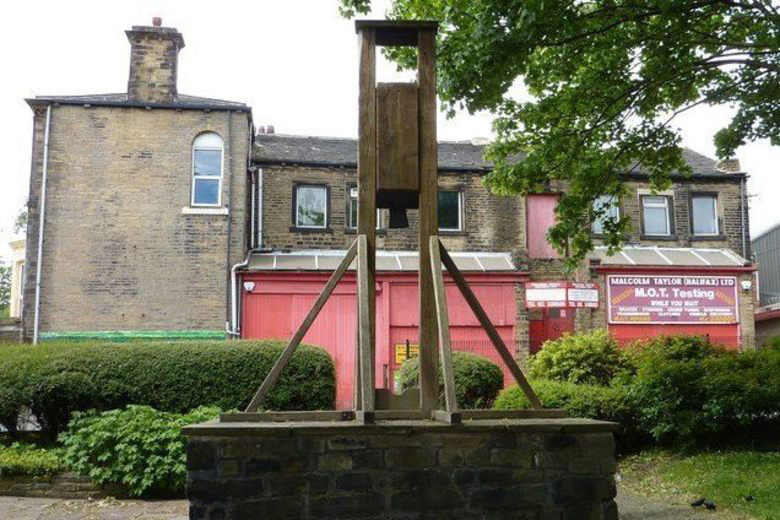
The Halifax Gibbet, Yorkshire, England (Photo: Atlas Obscura)
In Halifax, Yorkshire, stands a device that looks like it should belong in the aftermath of the French Revolution. First set up in the 1500s – though no one knows exactly when – the Halifax Gibbet was an early guillotine. Such a contraption seems to have been unique in England, where decapitation was usually administered by more straightforward tools like axes and swords.
Halifax was once part of the Forest of Hardwick. Here an ancient custom allowed the local lord to execute anyone accused of stealing goods worth 13½ pence or more, without needing to go through the inconvenience of holding a trial. This custom may have been a relic of the Anglo-Saxon infangthief tradition, which allowed lords to enforce summary justice on thieves caught within the boundaries of their estates.
Not that such things were uncommon in medieval England. In the reign of Edward I (1272-1307), 94 private gallows and gibbets were in operation in Yorkshire, including one owned by the Bishop of York. What was unusual about Halifax was that this custom lingered on into the 17th century, by which time public opinion had decided that the summary beheading of petty thieves was a little over the top.
By the time the guillotine was set up, the decision to execute was made by a jury rather than a feudal lord, but there was still no need for a judge, defence counsel or the taking of oaths. Interestingly, this law only applied in the Forest of Hardwick and the Halifax Gibbet stood about 500 yards (450 metres) from its boundaries. Two men are known to have dodged the blade by sprinting off and getting beyond the forest’s frontiers. Records show that at least 52 men and women were beheaded by the guillotine before its use was outlawed – despite much local opposition – in 1650.
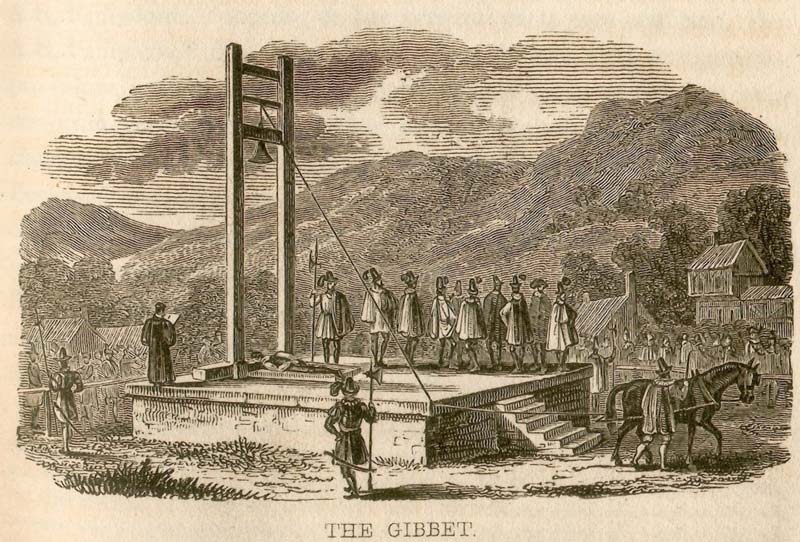
A sketch of the Halifax Gibbet in operation
The decapitation of petty thieves may have continued for so long in Halifax because it was a centre of the production of a type of cloth called kersey. As part of the manufacturing process, the cloth had to be hung outdoors to dry, making it an easy target for the light-fingered.
The Halifax Gibbet was dismantled after it had performed its final executions, but its stone platform was rediscovered in 1840. A full-sized (but non-working!) replica was set up on this base in 1974. The replica includes a blade made from a casting of the original. The original blade can be seen in the Bankfield Museum in Boothtown on Halifax’s outskirts. A plaque close to the replica lists the names of the 52 people known to have been executed by the guillotine.
Number 5: The Caxton Gibbet, Cambridgeshire
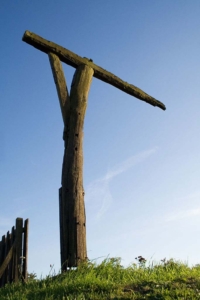
The Caxton Gibbet, Cambridgeshire (Photo: Andrew Dunn)
The Caxton Gibbet stands on the important ancient thoroughfare known as Ermine Street (now the A1198), which links London and Huntingdon, close to where it crosses the road (now the A428) connecting Cambridge and St Neots.
The Caxton Gibbet is unusual as local folklore associates it with a particularly gruesome method of execution – the placing of convicts in a gibbet cage while still alive. The prisoner would then die from thirst, exposure, starvation or a mixture of all three.
Local tales speak of a murderer who killed a man named Partridge. Upon being convicted, the criminal was suspended alive in a gibbet cage. A baker who tried to relieve his sufferings by offering him a piece of bread was sentenced to the same punishment.
There are, however, no court or burial records of such ordeals being inflicted at Caxton and live gibbeting seems to have been uncommon in England.
Tales of convicts being gibbeted at Caxton can be traced back to the 1670s and court records show the gibbet was still in use in 1745.
The Cambridgeshire antiquarian William Cole (1714-82) wrote, ‘About 1753 or 1754, the son of Mrs Gatward, being convicted of robbing the Mail, was hanged in chains on the Great Road. I saw him hanging in a scarlet coat. After he had hung two or four months, it is supposed that the screw was filed that supported him and he fell in the first high wind after.’
The Caxton Gibbet seems to have disappeared in the first decades of the 19th century. A replica was set up, probably in the early 1900s. As with the mock gallows at Busby Stoop, it may have been erected to drum up business for a nearby pub, also called the Caxton Gibbet.
Number 6: The Cage of John Breads’ Gibbet, Rye, East Sussex
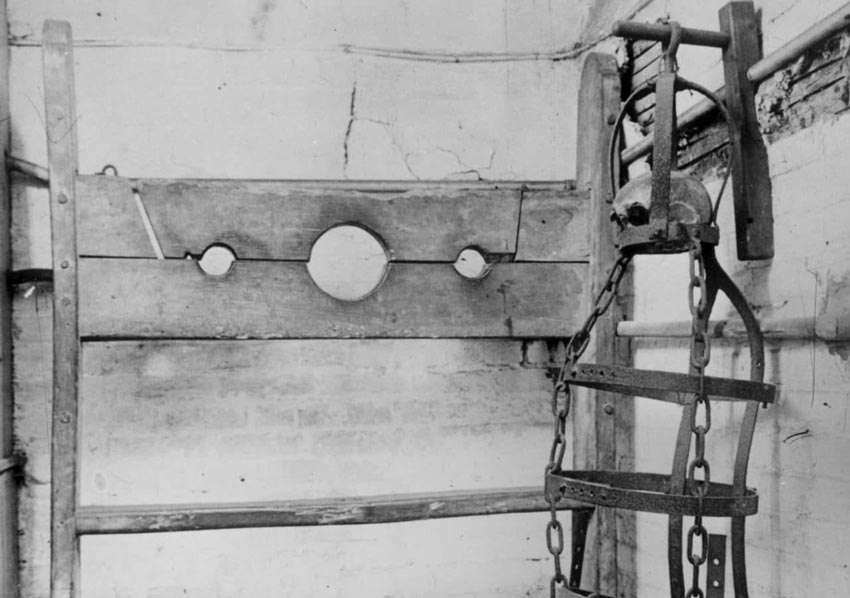
John Breads’ gibbet cage and part of his skull in Rye Town Hall, Sussex, England (Photo: nerdsonearth)
John Breads – an innkeeper and butcher from Rye – was in 1737 fined by the mayor James Lamb for cheating his customers with non-standard weights. Breads thereafter nursed a hatred of Lamb and – six years later – saw an opportunity to pay him back.
On 17th March 1743, James Lamb’s son John hosted a dinner party on a ship in Rye Harbour. John had invited his father to attend and Breads – having heard about the dinner – hid in a churchyard hoping to surprise James Lamb on his way home. Later that night, seeing a figure pass among the graves, Breads leapt out from behind a tombstone and thrust a knife into the person’s back. But the victim was not James Lamb. Lamb was ill and the man Breads stabbed was Lamb’s brother-in-law Allen Grebel, who’d gone to the dinner in his place.
In the gloom of the churchyard, Breads didn’t notice his error. He excitedly dropped his knife and ran away shouting, ‘Butchers should kill lambs!’ Grebel died of his wounds later that evening.
Breads was imprisoned in Rye Castle and – when he came to trial – he found his intended victim James Lamb was the presiding magistrate. Breads told him, ‘I did not mean to kill Mr Grebel. It was you I meant it for and I would murder you now if I could!’
On 8th June, John Breads was hanged outside the Strand Gate, Rye. His body was then placed in a cage on – the aptly named – Gibbet Marsh, where it was left to dangle for 50 years. The cage and Breads’ skull are now kept in the attic of Rye Town Hall. It’s said his other bones were stolen by old women and used as cures for rheumatism.
A mock cage with a mock skeleton can be seen in Rye Castle Museum, in the very cell where Breads was held. Like Thomas Busby, John Breads was permitted to enjoy a last pint in his pub – The Flushing Inn – before he faced the rope.
Though many of those gibbeted were hung with chains wrapped around their bodies, others – like Breads – were suspended in specially designed cages. For these, the blacksmith would often measure the convict, in the way a tailor might measure a man for a suit.
Number 7: Combe Gibbet, Berkshire
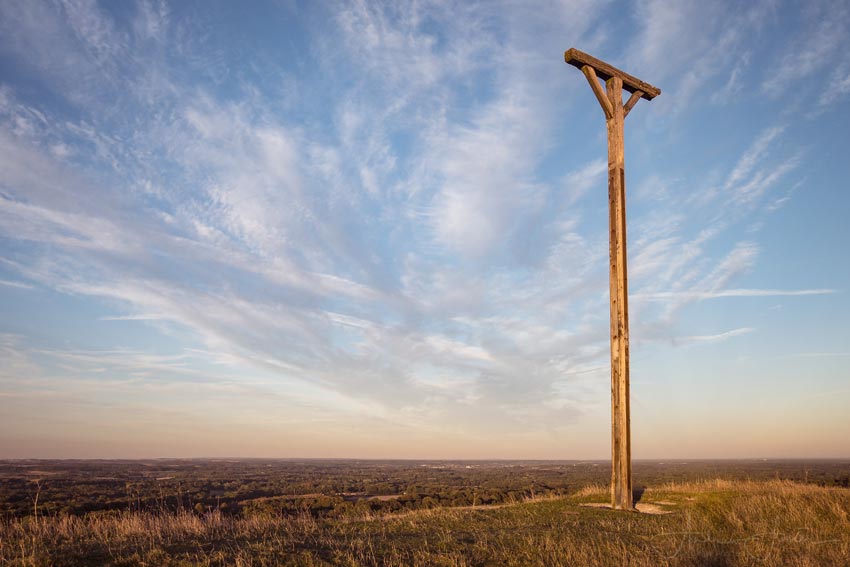
Combe Gibbet on Gallows Down, Berkshire, England (Photo: Andrew Foster)
This gibbet stands high on Gallows Down, near the village of Combe, Berkshire. It’s on the Test Way – an important long-distance footpath – and prominently sited on top of a long barrow.
Combe Gibbet was erected in 1676 to display the bodies of George Broomham and Dorothy Newman and was only ever used for them. The two were having an affair and they murdered Broomham’s wife Martha and son Robert when they stumbled upon the lovers on the downs.
Despite its sinister past, the gibbet now seems a centre of fun activities. It’s a tourist attraction and often surrounded by hang gliders and paragliders. The gibbet is the start of a scenic off-road run – the Combe Gibbet Race – which takes place every year.
Though the current gibbet is a replica – the original was dismantled years ago – a condition in the lease of a nearby farm states the gibbet must be properly maintained. Perhaps there’s a suspicion that someday this grim apparatus may once again come in handy.
Number 8: Brigg Gibbet, Lincolnshire
Brigg Gibbet, which stands on the A18 three miles east of Brigg, Lincolnshire, is unusual in that no wrongdoers were ever suspended from it. It was erected in the early 17th century as a warning, following a fight between two feuding local families, in which members of both clans died. King James I warned the families – the Rosses of Melton Ross and the Tyrwhitts of Kettleby – that any more killings would be treated as murder. The king had the gibbet set up to underline his point.
Number 9: The Bilstone Gibbet, Leicestershire
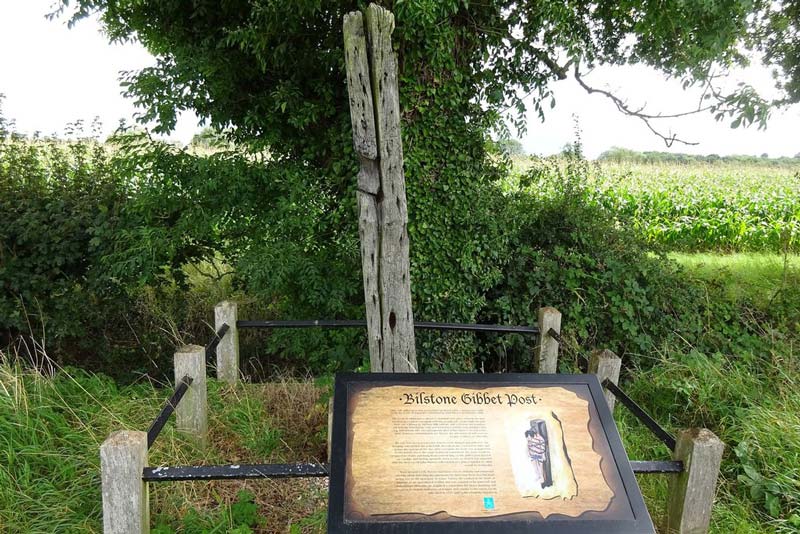
The remnants of the Bilstone Gibbet, Leicestershire, England (Photo: Ian Rob)
This gibbet post stands outside the hamlet of Bilstone, Leicestershire. The Bilstone Gibbet was erected to suspend the body of John Massey, a hard-drinking – and notoriously short-tempered – farmhand. John was famous locally as a wrestler and known as Topsy Turvey because of his trick of lifting opponents above his head before throwing them.
In 1801, after returning to Bilstone from a drinking session in the Curzon Arms, Twycross, Massey got into a violent row with his new second wife. After assaulting her, he picked her up and flung her into a mill stream. Though she didn’t drown, she died a few weeks later from her injuries. Massey also hurled her 10-year-old daughter – who’d tried to intervene – into the mill race. The daughter clambered out – shaken but unharmed – with the help of the mill keeper and would later give decisive evidence against Massey in court.
Following his trial, John Massey was hung, after which his body was suspended in chains from the Bilstone Gibbet for 18 years. By the time he was taken down, only a partial skeleton was left.
Unlike many of the gibbets in this article, this gibbet post – though eroded and worm-eaten – isn’t a replica but a remnant of the original object. Ancient iron bolts can still be seen in its wood.
Those who have lingered near the gibbet in the late evening have reported an unsettling sensation. Teenagers used to dare each other to walk up close to the gibbet at night, especially on Halloween.
Number 10: The Millom Gibbet, Cumbria
Near the town of Millom, Cumbria, a memorial stands next to a socket in the ground that once secured a gibbet post. As in the Forest of Hardwick, the local lords – the Huddleston family – had the right to execute suspects without all the troublesome hassle of court cases. The socket is all that remains of the gibbet that dispatched them.
The Decline of Gibbeting and Public Gallows
Though favoured by the courts as a theatrical method of deterrent, gibbeting was always a controversial practice. There were frequent complaints about the sight and smell of the decaying corpse and attempts were sometimes made to remove and bury bodies. One reason gibbet posts were so high was to make this difficult and some gibbets had nails sticking out of the wood to discourage any tempted to climb them to cut down the corpse.
The London diarist Samuel Pepys (1633-1703) expressed disgust at gibbeting and such sentiments seem to have grown as time went on. Though the Murder Act of 1751 stipulated that ‘in no case whatsoever shall the body of a murderer be suffered to be buried’ but should instead be dissected or hung in chains, this may well have been intended to reverse a decline in gibbeting.
The practice, however, became less common and objections to it more outspoken. Doubts were also rising about the moral instruction the sight of a gibbeting could impart. In one notorious case, a 16-year-old girl invited a friend to a picnic beneath a gibbet and fed her a poisoned cake, in revenge for her friend taking a job she’d coveted.
The last gibbetings in England were those of William Jobbing, a Jarrow miner, and James Cook, a Leicester bookbinder, both in 1832. Jobbing was soon cut down by his fellow miners and buried decently. Cook’s body was taken down by the authorities after a few days, following horrified complaints from nearby residents. Gibbeting was abolished in 1834.
Public hangings went on. Though such executions were often large-scale events, drawing thousands of onlookers, disquiet about them was also increasing.
Charles Dickens, after witnessing a public hanging, wrote a letter to The Times complaining of the ‘wickedness and levity of the immense crowd … The horrors of the gibbet and of the crimes which brought the wretched murderers to it faded in my mind before the atrocious bearing, looks and language of the assembled spectators.’
Dickens described many of these spectators as ‘thieves, low prostitutes, ruffians and vagabonds of every kind’ who indulged in ‘every variety of offensive and foul behaviour … fightings, faintings, whistlings … brutal jokes’ and ‘tumultuous demonstrations of indecent delight.’
As had been the case with gibbeting, uncertainties were growing about the virtuous effects of public executions on the masses. From 1868, hangings were carried out behind prison walls. The UK’s last ever hangings took place in 1964.
The landscape, however, remembers our brutality. We can see it in our place names – Gallowgate, Gibbet Marsh, Gibbet Lane, Gallows Down. Our cruelties are recalled by those replica gibbets, those flapping nooses, rain-filled sockets and worm-eaten posts that lurk eerily at England’s crossroads and waysides, reminding us of attitudes that have faded and will hopefully never re-emerge.
(The featured image, showing Winter’s Gibbet, is courtesy of johndal)

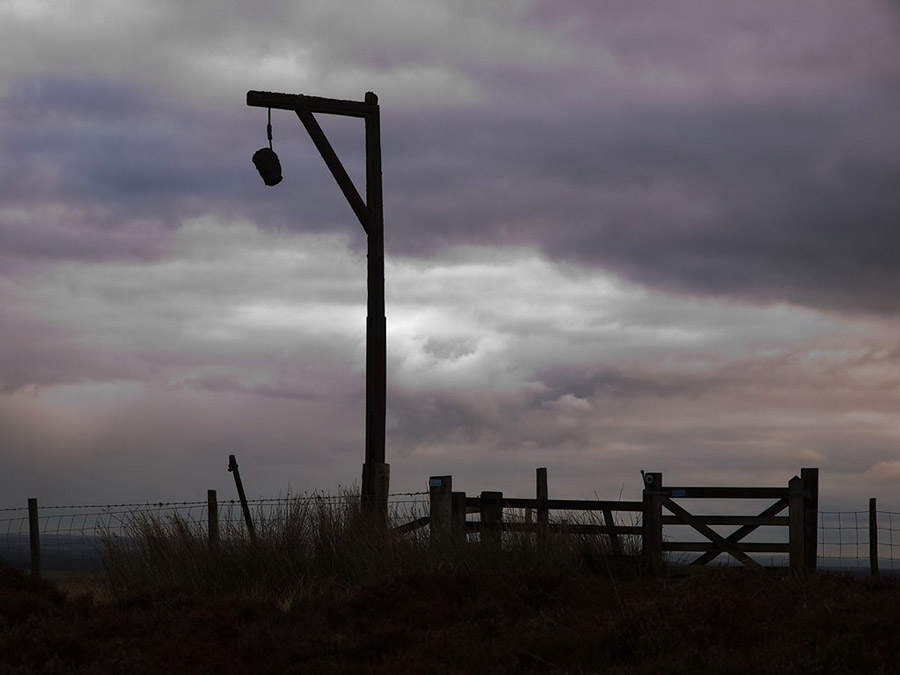
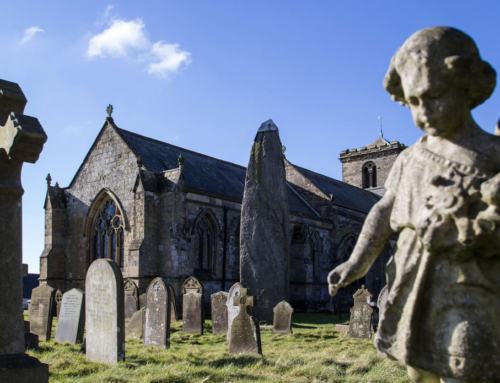

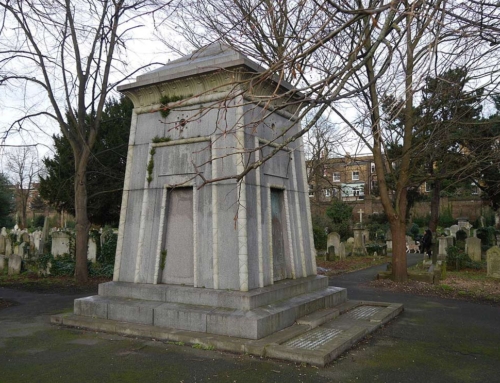
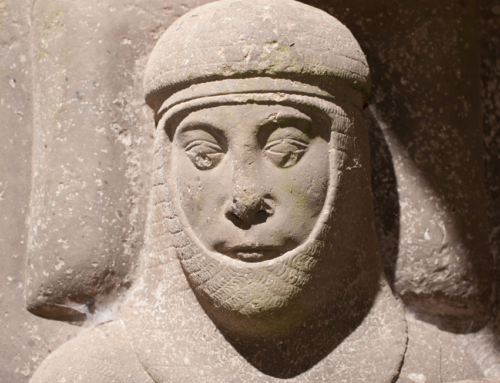
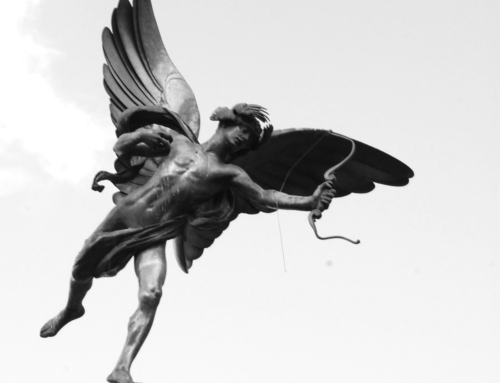
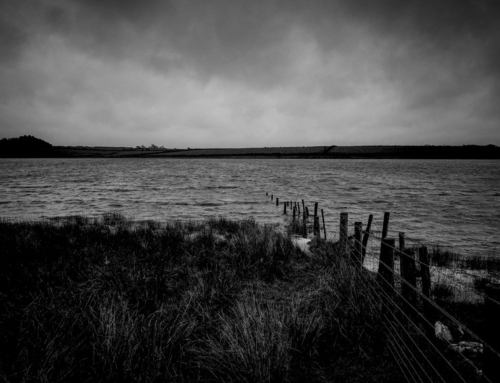
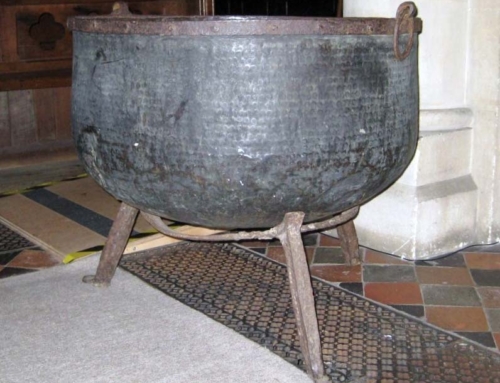
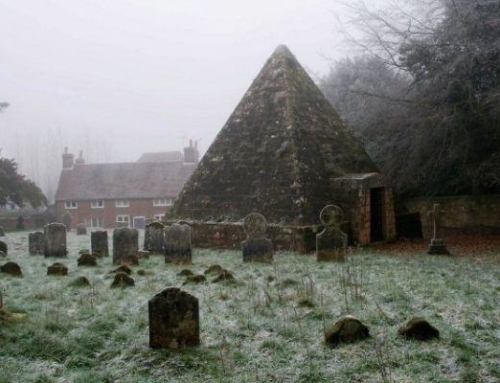
I live in Thornhill, Scotland and the surrounding area is filled with references to places of execution: Gallows Brae, Gallows Knowe and Gallows Flat etc. I wonder if some of these sites were the places of only one notorious execution, or were they all used many times over the years.
Hi Phil, thanks for your comment. If these sites hosted just gallows rather than gibbets, I suspect they’d have been used more than once.
There was a gibbet in Spalding, Lincs.. A second-hand one as it is said to have been moved there from Crowland. Do you have any details about it as I am writing a local history. Were there any other gibbets or gallows in south Lincolnshire?
Hi Andy, I’m afraid I don’t know about any other gibbets in south Lincolnshire, but if anybody else reading this does, please feel free to drop in a comment.
There is, standing in a wood, named ”Potsford wood” just outside Wickham market in Suffolk The original remains of the gibbet post (Around 8ft of it) used in 1689 to display the freshly hung body of one Jonah Snell who was executed on Gallows hill In Wickham. His body hung in the gibbet frame for 41years, only being cut down in 1740 He Murdered a father and son who were the local watermill owners
I have just made a video about it all telling the whole story. You can watch it here.
https://youtu.be/sWHV5PM5a0Y
In the village of Sibford Gower (Oxon) a 17th century painted beam has survived which I believe to be part of a gallows associated with the Battle of Edgehill (1642), perhaps erected by Royalists before the battle. Do you know of any other decorated gallows? For details see Cake and Cockhorse (Banbury Historical Society Journal) 2025
Thanks for your comment, Oswyn, very interesting. I can’t say I know of any decorated gibbets or gallows – might be an interesting topic for further investigation.
Hello David
I was wondering if you have written, or plan to write, a book about your execution site findings. I’d love to buy a copy if so.
Regards, Bev Barsby
Hi Bev, I’m afraid I haven’t written a book on the topic of execution sites. I have, however, written one about strange objects in churches and the weird legends associated with them: https://www.amazon.co.uk/Church-Curiosities-Strange-Objects-Bizarre/dp/1784424447/